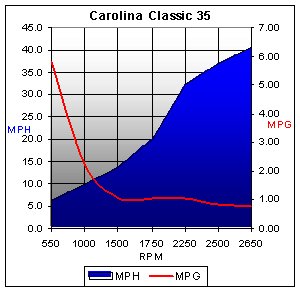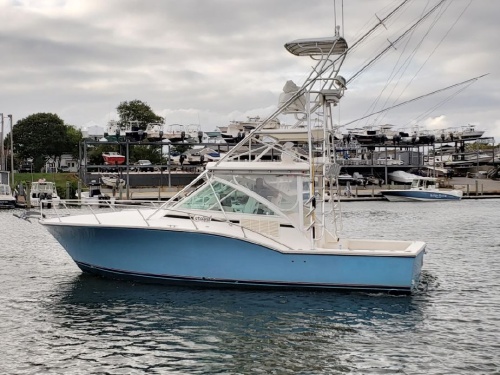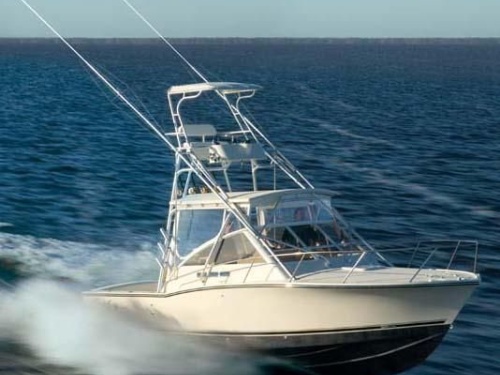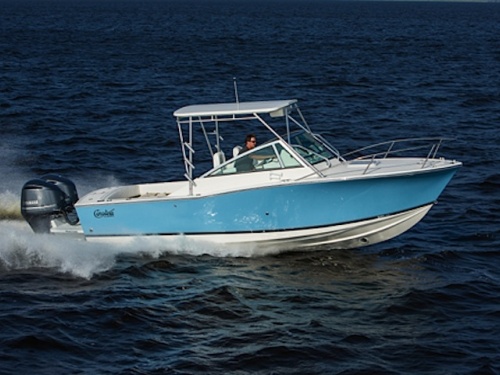Access More Boat Tests
Already have an account? Login
Carolina Classic 35 (2010-)
2 x 480-hp Cummins - Diesel
Brief Summary
The Carolina Classic 35 is strong sportfishing machine with good speed. She is designed for a day run to the canyons or a weekend cruise for a couple or small family. The bridge deck comes with an "L" lounger or forward-facing raised companion seat.
Key Features
- Bonded and mechanically fastened hull, deck and liner
- NMMA Certified
- Fiberglass encapsulated stringer system
- Solid fiberglass hull
- Molded fiberglass helm deck, hydraulically lifted, with full length gutters and cockpit control
- Tackle center with sealed drawers
- Engine access hatch
- Helm console, integrally molded, folds down for easy access to wiring and gauges; gasket sealed to resist moisture
- Storage cabinet at helm
- Optional "L" shaped lounge portside with storage below
Test Results
| RPM | MPH | Knots | GPH | MPG | NMPG | STAT. MILE | NM | dBa |
|---|---|---|---|---|---|---|---|---|
| 550 | 6.4 | 5.6 | 1.1 | 5.82 | 5.06 | 2278 | 1981 | 70 |
| 1000 | 9.9 | 8.6 | 4.4 | 2.25 | 1.96 | 881 | 766 | 80 |
| 1500 | 13.7 | 11.9 | 12.7 | 1.07 | 0.93 | 421 | 366 | 87 |
| 1750 | 19.9 | 17.3 | 19.1 | 1.04 | 0.91 | 408 | 355 | 89 |
| 2250 | 32.5 | 28.2 | 30.9 | 1.05 | 0.91 | 411 | 358 | 90 |
| 2500 | 37 | 32.2 | 43 | 0.86 | 0.75 | 337 | 293 | 92 |
| 2650 | 40.6 | 35.3 | 50.8 | 0.8 | 0.69 | 313 | 272 | 91 |

Specifications
| Length Overall | 34' 9'' |
|---|---|
| Beam | 13' 6'' |
| Dry Weight | 25,000 lbs. (wet) |
| Draft | 3' 0'' |
| Deadrise/Transom | 18 deg. |
| Max Headroom | 6' 4'' |
| Bridge Clearance | N/A |
| Fuel Capacity | 400 gal. |
| Water Capacity | 60 gal. |
Acceleration Times & Conditions
| Time to Plane | 14.9 sec. |
|---|---|
| 0 to 30 | 17.9 sec. |
| Ratio | 1.76:1 |
| Props | 24'' x 32'' stainless steel high DAR |
| Load | 4 persons, 3/4 fuel, minimal water, minimal gear |
| Climate | 63 deg., 55% humid., wind: 5 mph; seas: 0-1' chop |
Engine Options
| Tested Engine |
2 x 480-hp Cummins - Diesel |
|---|---|
| Std. Power |
2x480 Cummins 6C |
| Opt. Power |
Not Available |
Captain's Report
By Capt. Manny Rebelo (N.A.M.S.)
Functional styling, outstanding sea keeping ability, and a fair amount of creature comforts spells Carolina Classic’s 35. Her hull has the traditional Carolina sport fish flared bow born from running in the serious waters off the mid-Atlantic coast.
Below the water line she has an 18-degree deadrise with healthy reverse chines and planing strakes. Add in the traditional flared bow and you’re talking about a hull that is relatively dry, did not even pound once, and handled well during my test. So responsive was the vessel to her rudders that even maneuvering in the harbor, on one engine in clutch, (idling in forward gear), she responded well to the helm even when turned towards the running engine side. But she is heavy, 30,000 lbs. wet, so you need to take off headway before spinning her into a slip.
Construction
Mac Privott, the president of Carolina Classic told me that the hull of the 35 is hand laid up woven roven fiberglass with the bottom to a thickness of about 1 ½”. Unlike other manufacturers, the boys over at Carolina Classic are less concerned about weight than strength so there is no coring here just fiberglass and plenty of it. This can also be seen in the way they attached the longitudinal stringers and deck to the hull.
The hull to deck joint is the most critical section to any vessel's strength and here they actually used several layers of woven roving to attach the deck to the hull. And as if that is not enough, stainless steel through bolts with washers and fiber lock nuts are also used and closely spaced creating a one-piece boat, or as Carolina Classic likes to call it “unitized construction”. Hull-deck joints don't get any better.
Up on the bow there was no anchor pulpit or windless to get in the way of a clear deck aside from the two solid stainless steel cleats and chocks. For that matter, all the deck hardware was solid stainless steel with through bolted stainless steel fasteners and backing plates. Due to the flare of the hull the foredeck looks and actually is quite large, featuring a Bomar hatch and a stainless steel welded railing that runs down both sides about 2/3 of the way aft.
At The Helm
The lower center panel of the windshield can be opened mechanically to cool of the helm area and does it very well. The helm itself was hydraulic and didn’t tilt but the way the seat and console were situated there was no need to. The helm, as is everything else on a Carolina Classic was the best available, but don’t expect thick cushions, padded armrests, or nifty little cup holders in designer colors. This seat was made for the long run, without wood or anything that can rot. The instrument panel can hold a 12'' screen.
What’s a truly complete sportfish without a tower? Here again they designed the optional tower and upper station with only the serious fisherman in mind. No fancy whistles and bells, just what you need and plenty of it. For example, rocket launchers lined the tower’s uprights and across the back, 12 in all on the tower with an additional 4 in the cockpit.
The Cockpit
Back down in the cockpit there was nothing to get in the way of her intended use of fishing. The entire area was clear and ringed with vinyl bolsters along the deck line so when you’re fighting with that trophy fish you don’t wind up bruising your legs.
There are two 50-gallon molded fiberglass tubs mounted in the aft deck with weather sealing and latches. Each 50-gallon deck tub has a drain that will only work when its macerator pump is switched on to help prevent clogs. The bait station is situated along the back of the "L" shaped seat on the bridge deck.
Down Below
Even though the rest of the boat is a dead on serious fishing machine, below is just the opposite. Below I found soft cream-colored leather couches, beautiful teak cabinets and Corian countertops. The main berth is a large double for two with a tabletop with base stowed below as well as additional storage and the air conditioner unit as well.
On the opposite side is a very well-equipped galley with microwave, two-burner cooking surface, refrigerator, stainless steel sink with hot and cold water, Corian counter top, TV/VCR, and Sony stereo system with waterproof remote at the helm. Just aft of the galley is a comfortable head with a Corian countertop, fiberglass bulkheads and sole with drain for the shower. All made for easy clean up.
The Power Plant
Now let’s talk about what pushes this whole thing through the water. For my test the 35 was powered with twin C6 480-hp Cummins diesels with ZF 280 A-I transmissions. It’s a bit tight in the engine room but all areas were fairly accessible. One thing that stood out was the redundancy in systems and components throughout the vessel. A comforting thought when you are 100 miles offshore.
This sportfisher was up and gone, hell-bent for speed, topping out at 40.6 mph, or 35.3 knots. But her best cruising speed was also formidable at 32.5 MPH (28.2 knots) on a mere 30.9 GPH. That translates into 411-mile (358 NM) range. Another way to look at it is 1.05 miles per gal of fuel so you can go further and stay longer with plenty to spare.
There were plenty of other nifty things in the engine room and throughout the boat, more than I have time and paper to list. All in all she was a tough boat that deserves a closer look next time you see her around.
Noteworthly
There are several things in the standard Carolina Classic 35 that I think are particularly noteworthy. First, the engine room air intakes are above the boat's shear and sidedecks in the superstructure, not lower down in the side of the boat's hull. The bildge under the cabin is separated from the engine room to avoid odors and oil. The bildge is gel coated and the 35 comes standard with the Algae-X system.
Recommendation
There are a number of models on the market in this class. Buyers need to carefully study their engine room installations and attention to detail. All these boat look pretty much the same, but they are not.



